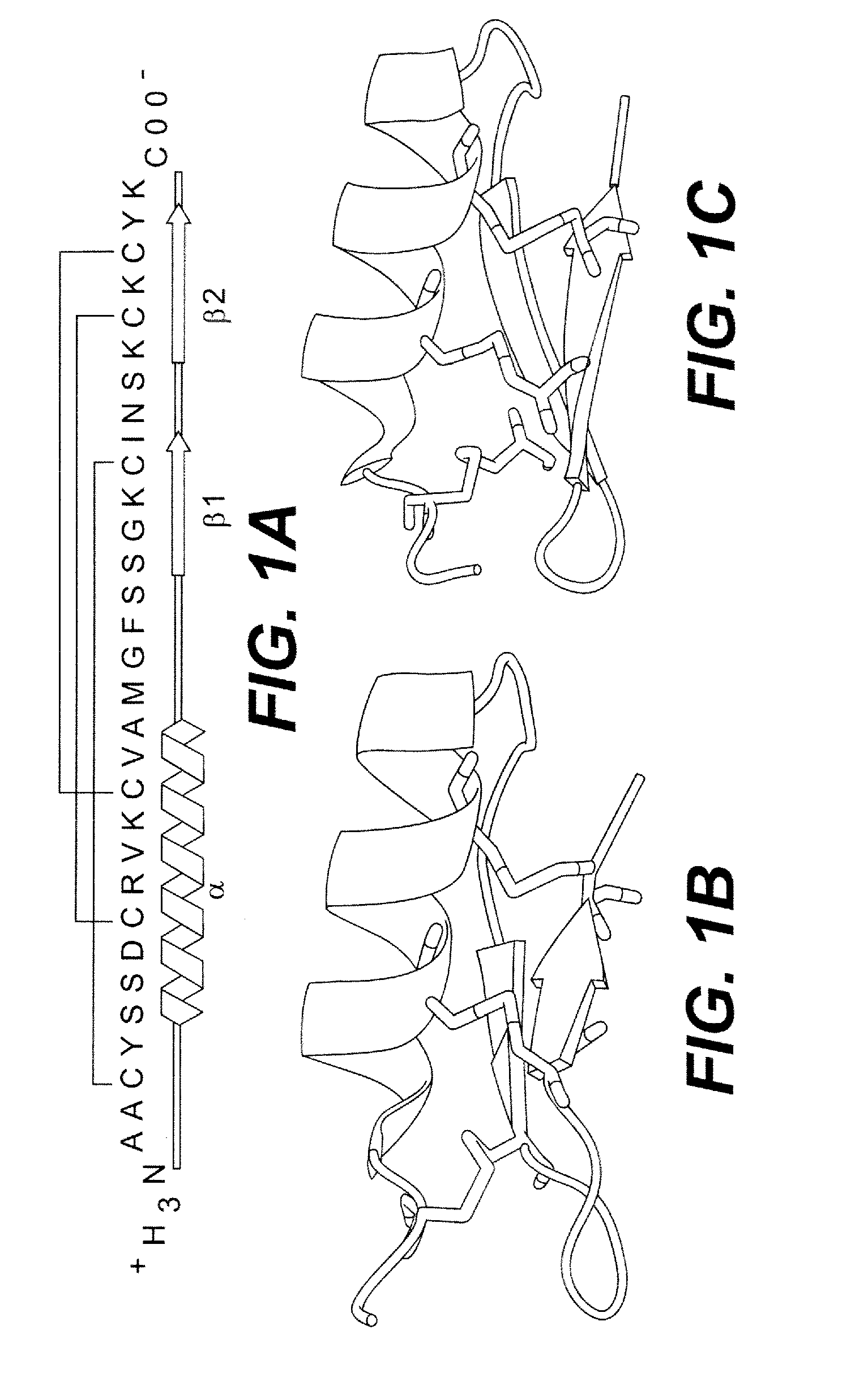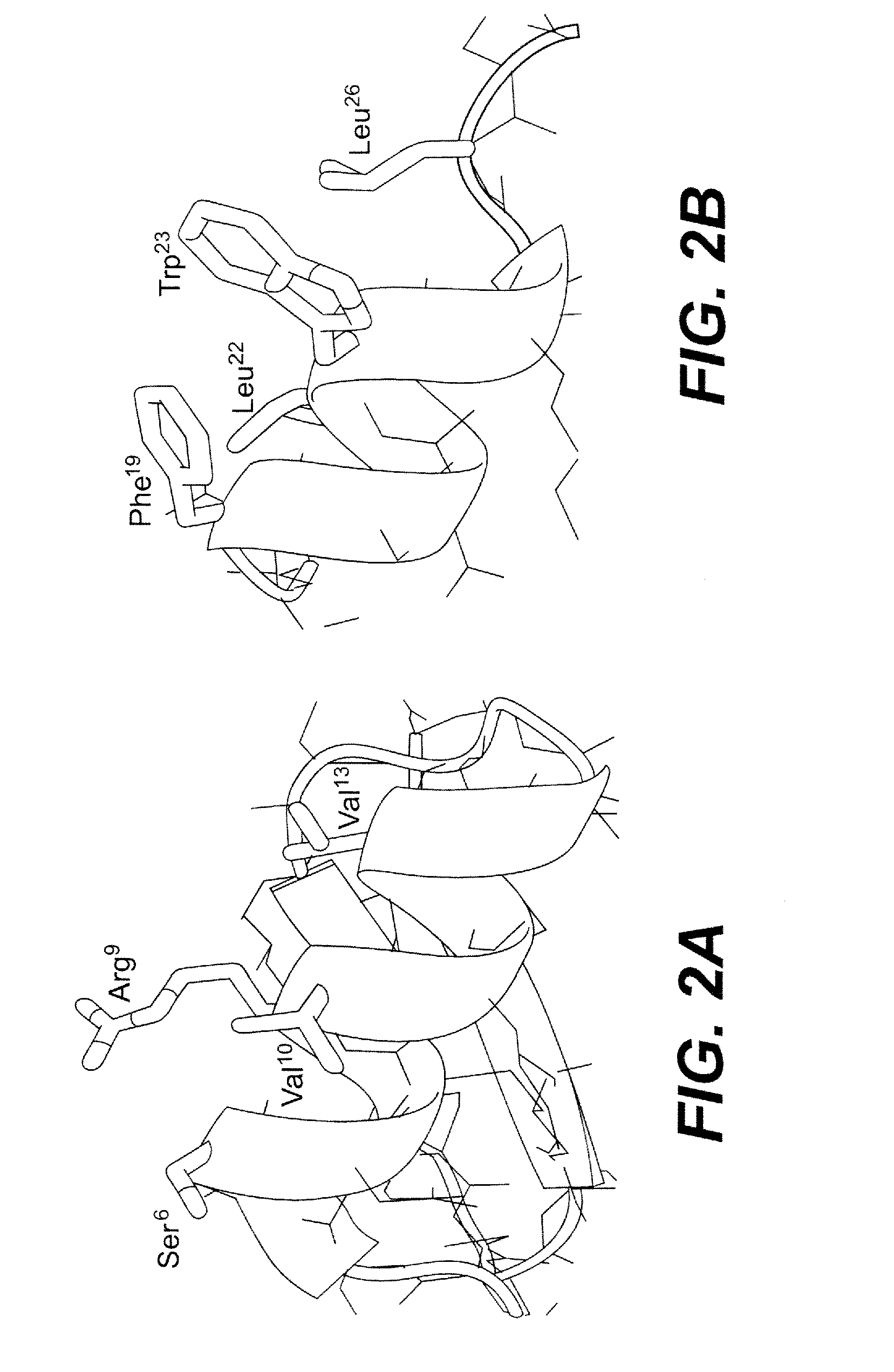P53 Activator Peptides
a technology of activator peptides and peptides, which is applied in the field of polypeptides, can solve the problems of limiting the therapeutic value of peptides, affecting the practical use of small molecules, and peptides generally exhibit excessive backbone flexibility and poor membrane permeability
- Summary
- Abstract
- Description
- Claims
- Application Information
AI Technical Summary
Problems solved by technology
Method used
Image
Examples
example 1
Chemical Synthesis of BmBKTx1 Scorpion Toxin
[0104]BmBKTx1 is a 31-amino acid residue K+ channel toxin isolated from the venom of the Asian scorpion Buthus martensi Karsch. BmBKTx1 was synthesized on Boc-Lys(2ClZ)-OCH2-PAM resin using a custom-modified, machine-assisted chemistry tailored from the published in situ DIEA neutralizationi'HBTU activation protocol for Boc solid phase peptide synthesis. The following side-chain protections were used: Cys(4MeBzl), Asp(OcHxl), Lys(2ClZ), Asn(Xanthyl), Arg(Tosyl), Ser(Bzl) and Tyr (BrZ). After chain assembly, the peptide was cleaved and deprotected by HF for 1 h in the presence of 5% p-cresol / thiocresol (1:1) at 0° C., followed by precipitation with cold ether. The crude product was purified by RP-HPLC to homogeneity, and its molecular weight ascertained by ESI-MS. Oxidative folding of purified BmBKTx1 was performed by dissolving the peptide at 3 mg / ml in 6 M GuHCl containing 18 mM reduced glutathione and 1.8 mM oxidized glutathione, followe...
example 2
Design and Synthesis of Stoppin-1
[0105]Shown in FIG. 2 is a side-by-side comparison between the N-terminal α-helix of BmBKTx1 and the helical segment of (15-29)p53 complexed with MDM2. It appears that Phe19, Trp23 and Leu26 of p53 are the three most important residues in MDM2 binding. To turn BmBKTx1 into an inhibitor of MDM2, residues Ser6, Arg9, Val10, and Val13 in BmBKTx1 were replaced with topologically equivalent residues from p53, i.e., Phe19, Leu22, Trp23, and Leu26. In addition, the two N-terminal residues Ala1 and Ala2, and the two C-terminal residues Tyr30 and Lys31 were deleted, resulting in a 27-residue peptide of the following sequence termed stoppin-1: CYSFDCLWKCLAMGFSSGKCINSKCKC (SEQ ID NO:1). Stoppin-1 was synthesized and oxidatively folded in large quantities essentially as described previously for BmBKTx1. Shown in FIG. 3 is stoppin-1 as analyzed by HPLC and ESI-MS. The determined molecular mass of 3021.1 Da is in good agreement with the expected value of 3030.7 Da...
example 3
Structure and Binding Activity of Stoppin-1
[0106]Stoppin-1 was characterized using CD and fluorescence spectroscopy. As shown in FIG. 3, stoppin-1 adopts a partially α-helical conformation in aqueous solution (10 mM phosphate buffer, pH 7.2), as indicated by double minima at 208 and 222 nm and a strong positive peak at 195 nm. The CD results are entirely consistent with the known structural features of BmBKTx1. As is the case with (15-29)p53, the only Trp residue engineered into stoppin-1 is fully solvent exposed in aqueous solution (butler) as evidenced by the Trp fluorescence maximum (356 nm). Addition of synMDM2 (synthetic MDM2—comprising amino acids 25-109 of the full length MDM2 protein) to stoppin-1 caused a dramatic shill of Trp fluorescence by 28 nm (from 356 nm to 328 nm), suggesting that stoppin-1 binds to synMDM2 in a way similar to (15-29)p53.
[0107]To evaluate the binding affinity of stoppin-1 for synMDM2 and synMDMX (synthetic MDMX—comprising amino acids 24-108 of the f...
PUM
| Property | Measurement | Unit |
|---|---|---|
| body weight | aaaaa | aaaaa |
| particle size | aaaaa | aaaaa |
| molecular mass | aaaaa | aaaaa |
Abstract
Description
Claims
Application Information
 Login to View More
Login to View More - R&D
- Intellectual Property
- Life Sciences
- Materials
- Tech Scout
- Unparalleled Data Quality
- Higher Quality Content
- 60% Fewer Hallucinations
Browse by: Latest US Patents, China's latest patents, Technical Efficacy Thesaurus, Application Domain, Technology Topic, Popular Technical Reports.
© 2025 PatSnap. All rights reserved.Legal|Privacy policy|Modern Slavery Act Transparency Statement|Sitemap|About US| Contact US: help@patsnap.com



